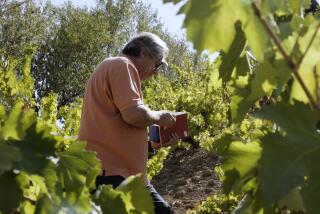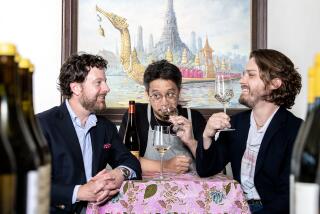Moseying Along the Mosel
- Share via
KOBLENZ, Germany — I’ve never much liked the Rhine--too much industrial traffic, too muddy. But, ah, the Mosel! From my perch about 400 feet above where the rivers converge, I am struck anew by the differences: the Rhine, wide and brown and churning with tugs and barges; the Mosel, clear and placid after its long meander between vineyards and castles.
This was not my first visit; I was here five years earlier, in autumn. It was at the height of harvest festivities, and crews of pickers were still working, moving quickly through the rows, hoping to outrun the frosts that come early to the Mosel. To the 120 villages tucked into the bends of the river, all of which live by and for wine, a harvest that beats the frost is reason for celebration. Village wine gardens and streets were bursting with weekenders singing and dancing and waving their glasses in toasts and greetings. Susser, new wine, was the celebratory drink; Zwiebelkuchen, an onion tart spiked with caraway seeds and sprinkled with bacon, the perfect accompaniment.
Now it was 1999, and I was back on the opposite side of the vintners’ calendar, May, when green sprouts begin to emerge from the vines’ winter-bare branches.
My travel companion, David, and I had a week to meander the Mosel wine region, from Koblenz upstream to Trier, near Germany’s border with Luxembourg. (The river begins in the Vosges Mountains of France, where it is called the Moselle.) Although the “wine route” is only 125 miles long, most of those miles are in loops, which makes for slow going.
To guide us, I had a charming map I’d picked up on my last visit. Its title invariably tickles visitors whose language is English: “Die Grosse Moselfahrt,” disappointingly translated as “The Great Mosel Trip.” The map unfolded like an accordion to 14 sections detailing with Disney-like drawings villages, landmarks, bridges, roads and walking paths along the way. A travel guide in English was attached.
As we drove out of Koblenz, I discovered that we were on the opposite side of the river from where we wanted to be. The next bridge was a half-hour’s drive away. But I saw on the map a dotted line marking a ferry. We drove on board for a five-minute, open-air crossing on a car ferry built for two, complete with geraniums flourishing in the wheelhouse window boxes.
At Kobern-Gondorf, just south of Koblenz, we turned away from the river to drive into the idyllic Muhlental Valley, to the exquisitely restored 13th century chapel of St. Matthias. There, following a footpath marked by the stations of the cross, we came to the remains of the Oberburg castle, built in the 12th century by the powerful Knights of Leyen. From here a long view of the Mosel revealed its incredible path--a view not discernible when one is negotiating its edges by car--so twisting that in places it appears to double back on itself.
Castles bristle on rocky perches all along the Mosel. But the one I was most eager to see, Burg Eltz, is deep in a forest, reached by a footpath.
Burg Eltz, stronghold of the Counts of Eltz since 1157, is so perfectly proportioned that its likeness decorates the 500-Deutsche Mark bill. Fourteen of its 80 rooms are open for touring, lovingly restored, authentically and charmingly furnished by the current Eltz owner.
The family “treasure chamber” consists of five rooms, originally storerooms, filled with breathtakingly extravagant items acquired through the centuries. Among them are numerous drinking vessels wrought in gold, reminding that wine is no newcomer to the Mosel.
Romans were the first to terrace the valley’s steep slopes for the cultivation of grapes. One has to wonder that viticulture has endured through the centuries in this most difficult of wine-producing regions. Sudden frosts in May or June have destroyed entire crops; heavy midsummer rains often bring mold; August hailstorms may batter the grapes; early frosts will blight them. A maximum yield rarely occurs more than once in a decade, according to the German Wine Institute.
Most of the 13,000 vineyards in the region are small, family-owned holdings. The winemaking--riesling is the dominant grape--takes place in the villages, with almost every house devoting its adjoining courtyard to the process. A Weingut sign out front signals that visitors are welcome for a tasting.
So it was at Weingut Franzen in the village of Bremm. We went there because the waiter pouring our wine the night before had mentioned that it came from the steepest slopes along the Mosel, the steepest in Europe, perhaps the world.
To see for ourselves, we drove to the top of the Franzen Calmont vineyard. Below--dizzyingly below, since the slope was 65 degrees--was what’s said to be the tightest bend of the Mosel.
It is possible to drive the length of the Mosel in one day. But that would be a mistake. Dedicated bicycle paths hug the curves of the river from Koblenz to Trier, with bike rentals readily available. Riverboats of varying sizes post timetables that tie many villages together. Footpaths are designed for bird’s-eye views of the countryside or as a shortcut between a here and a there. The joys of the Mosel come in meandering, stopping to enjoy a picturesque village, a glass of beer at a sidewalk table, a hike to a castle ruin just because it is oh-so-romantically there.
At Traben-Trarbach--once separate towns with 13th century castles that glared at each other across the river until a bridge hyphenated the two in 1904--we left the car and set out on foot for Bernkastel-Kues, another twinned town. The overhill shortcut was about three miles; by road the route is about 20 miles, thanks to an enormous bend in the river.
The trail wound its way up through a forest brightened with wildflowers and opened at the top to Bernkastel’s vineyards and a wonderful view of the fairy-tale town below. Descending in no time, we rewarded ourselves with lunch at Hotel zur Post--tarragon soup, knuckle of pork with sauerkraut and, for dessert, a medley of fresh berries topped with cream.
Across the river at Kues, a 15th century theologian, Nikolaus Cusanus, founded a religious and charitable institution complete with vineyard. The vineyard and a complex of Gothic buildings remain, among them St. Nikolaus Hospital. In the hospital’s vaulted cellars, for a small admission fee visitors can taste and compare from among 130 local wines.
We boarded a riverboat for the return to Traben-Trarbach and took a seat on the open deck to take advantage of a brisk and sobering breeze.
Spotless Zimmer frei (bed-and-breakfasts), full-scale hotels, picturesque inns--accommodations abound in the villages of the Mosel. But only one castle takes lodgers: Schloss Zell.
On the drive into Zell, we scoured the hilltops above the town’s world-renowned Zeller Schwarze Katz vineyards, looking for the promised Schloss (castle). Following the arc of the river, we came to the marketplace where a statue celebrates the Zeller label’s Black Cat. Continuing on, we were surprised to find Schloss Zell not on a craggy lookout but solidly positioned in the middle of town.
The Schloss is a work in progress by the Schneider family, who nearly 10 years ago saw promise where others saw decay. So far, eight guest rooms--reached by a steep spiral staircase--have been elegantly renovated. From my down-puffed bed, I gazed up at a church-like vaulted ceiling.
In the Schloss restaurant, in space that was once the castle’s wine cellar, we feasted on white asparagus--the month of May’s celebratory gift to Germany--swathed in rich hollandaise sauce and flanked by thinly sliced ham rolled into cylinders. A bottle of Zeller Schwarze Katz washed it down just fine.
In the last third of the journey, toward Trier, the Mosel’s valley gradually begins to widen. While the landscape becomes less picturesque, ancient history comes to the fore. In Neumagen, settled by the Romans in the 4th century, the marketplace holds a stone funerary monument that depicts a Roman wine boat on a choppy-looking Mosel manned by a dozen or so straining oarsmen. (This is a replica; the original, unearthed nearby, can be seen with hundreds of other antiquities at the Rheinisches Landesmuseum in Trier.)
My guidebooks were full of tantalizing anecdotes: A vintner stumbled on Roman coffins while cleaning out the deepest of his cellars. Another, while laying the foundation for a new house, plunged into a Roman bath. While harrowing a field, yet another uncovered a complete mosaic floor.
With this buildup, I was eager to see Trier, once a capital city of the Roman Empire that ranked in importance with Alexandria and Constantinople. There’s even a sign in the main square inscribed in Latin, which boasts: “Trier existed 1,300 years before Rome.”
A tour of Trier must begin at the Porta Nigra, the Black Gate, one of the grandest Roman structures in northern Europe. It once stood in the wall that encircled the city. Less than a mile away is the ruin of the Roman amphitheater. Between the two sites is a pedestrian-only zone where the buildings are done in a cornucopia of styles--Romanesque, Gothic, Baroque and so on--the result of architectural quarrying in which buildings were dug up or dismantled over the centuries to provide materials for replacements or remodeling.
The most walkable of cities, with a population that today exceeds only by 19,000 the 80,000 of the Caesars’ era, Trier is worth days of exploration. The evening before we were to leave, I came upon a tiny street with a curious name, Sieh um Dich, which translates to “look around yourself.” It seemed both redundant and late to be giving such advice. How can one do anything else when traveling, as Die Grosse Moselfahrt guide-map described it, the most wondrous vineyard route in the world?
(BEGIN TEXT OF INFOBOX / INFOGRAPHIC)
GUIDEBOOK
Enchantment on the Mosel River
Getting there: Lufthansa, Delta and Air New Zealand fly nonstop from Los Angeles to Frankfurt. Round-trip fares start at $502.
Rent a car--major American rental agencies are at the airport--and set aside time for a ferry ride or two; ferries make frequent daily stops at a dozen towns between April and October.
Where to stay: Hotel-Restaurant Weismuhle, D-56812 Cochem; telephone 011-49-2671- 8955, fax 011-49-2671-8207. A converted old mill in a secluded setting; room and breakfast, $43 to $47 per person. Restaurant serves contemporary German cuisine.
Schloss Zell, D-56856 Zell/ Mosel; tel. 011-49-654-298-860, fax 011-49-654-298-8690. Doubles in this renovated castle run $85 to $100 with breakfast. Open May 8 through February.
Hotel Villa Hugel, Bernhardstrasse 14, 54295 Trier; tel. 011- 49-651-33066, fax 011-49-651- 37958. An Art Nouveau villa on a hill within easy walking distance of the city center. Doubles, $90 to $135. The hotel’s restaurant is bright; dinner entrees from $13 to $25.
Where else to eat: Weinhaus Hubertus, Florinsmarkt 34, SW73 Koblenz; local tel. (0261) 31177. Half-timbered 17th century house; inexpensive hearty fare. Locally popular. Entrees range from $5 to $10.
What to do: Mosel Wine Week, June 21 to 25, and the Wine Festival, Aug. 24 to 28, will be held in the town of Cochem.
For more information: German National Tourist Office, 122 E. 42nd St., 52nd Floor, New York, NY 10168; tel. (212) 661-7200, fax (212) 661-7174, Internet https://www.germany-tourism.de.
More to Read
Sign up for The Wild
We’ll help you find the best places to hike, bike and run, as well as the perfect silent spots for meditation and yoga.
You may occasionally receive promotional content from the Los Angeles Times.






